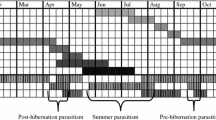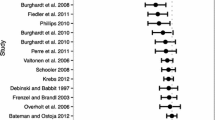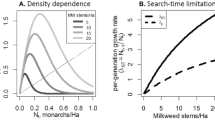Abstract
Context
Habitat fragmentation can have contrasting effects on species and their interactions within communities, changing community structure and function. Parasitoids and pathogens are key natural enemies in invertebrate communities, but their responses to fragmentation have not been explored within the same community.
Objectives
This study aimed to explore the scale-dependent effects of habitat fragmentation on the population density of a lepidopteran host and particularly its trophic interactions with a specialist parasitoid and virus.
Methods
Host density and host larval-mortality from the parasitoid and the virus were measured in twelve isolated sites and thirteen connected sites. An index of habitat isolation was created based on the amount of suitable habitat surrounding sites at a range of spatial scales (0.1–5 km radii), and the direct and indirect effects of habitat isolation were analysed using generalised linear mixed effects models.
Results
Consistent with predictions, habitat isolation had direct negative effects on host density at the smallest and largest spatial scales, and indirect negative effects on host mortality from the virus at the largest scale, but in contrast to predictions it had direct positive effects on parasitism at small and medium scales.
Conclusions
Higher trophic level species may still display responses to habitat fragmentation contrary to predictions based on well supported theory and empirical evidence. The mechanisms underlying these responses may be elucidated by studying responses, contrary to expectations, shared by related species. Developing general predictions about the responses of host-pathogen interactions to fragmentation will require greater understanding of the system-specific mechanisms by which fragmentation can influence pathogen transmission.




Similar content being viewed by others
References
Allan PBM (1979) Larval food plants. Watkins & Doncaster, London
Allan BF, Keesing F, Ostfeld RS (2003) Effect of forest fragmentation on lyme disease risk. Conserv Biol 17(1):267–272
Anderson RM, May RM (1981) The population-dynamics of micro-parasites and their invertebrate hosts. Philos T Roy Soc B 291(1054):451–524
Bates D, Maechler M, Bolker B (2012) lme4: Linear mixed-effects models using S4 classes. http://cran.r-project.org/web/packages/lme4/
Begon M, Sait SM, Thompson DJ (1996) Predator-prey cycles with period shifts between two- and three-species systems. Nature 381(6580):311–315
Begon M, Sait SM, Thompson DJ (1999) Host-pathogen-parasitoid systems. In: Hawkins BA, Cornell HV (eds) Theoretical approaches to biological control. Cambridge University Press, Cambridge, pp 327–348
Bender DJ, Contreras TA, Fahrig L (1998) Habitat loss and population decline: a meta-analysis of the patch size effect. Ecology 79(2):517–533
Bjornstad ON, Falck W (2001) Nonparametric spatial covariance functions: estimation and testing. Environ Ecol Stat 8(1):53–70
Bonsall MB (2004) The impact of diseases and pathogens on insect population dynamics. Physiol Entomol 29(3):223–236
Boots M, Greenman J, Ross D, Norman R, Hails R, Sait S (2003) The population dynamical implications of covert infections in host-microparasite interactions. J Anim Ecol 72(6):1064–1072
Boots M, Hudson PJ, Sasaki A (2004) Large shifts in pathogen virulence relate to host population structure. Science 303(5659):842–844
Boots M, Mealor M (2007) Local interactions select for lower pathogen infectivity. Science 315(5816):1284–1286
Brownstein JS, Skelly DK, Holford TR, Fish D (2005) Forest fragmentation predicts local scale heterogeneity of Lyme disease risk. Oecologia 146(3):469–475
Brückmann SV, Krauss J, van Achterberg C, Steffan-Dewenter I (2011) The impact of habitat fragmentation on trophic interactions of the monophagous butterfly Polyommatus coridon. J Insect Conserv 15(5):707–714
Burden JP, Griffiths CM, Cory JS, Smith P, Sait SM (2002) Vertical transmission of sublethal granulovirus infection in the Indian meal moth, Plodia interpunctella. Mol Ecol 11(3):547–555
Burden JP, Nixon CP, Hodgkinson AE, Possee RD, Sait SM, King LA, Hails RS et al (2003) Covert infections as a mechanism for long-term persistence of baculoviruses. Ecol Lett 6(6):524–531
Burnham KP, Anderson DR (2002) Model selection and multimodel inference: a practical information-theoretic approach. Springer, New York
Cagnolo L, Valladares G, Salvo A, Cabido M, Zak M (2009) Habitat fragmentation and species loss across three interacting trophic levels: effects of life-history and food-web traits. Conserv Biol 23(5):1167–1175
Chaplin-Kramer R, O’Rourke ME, Blitzer EJ, Kremen C (2011) A meta-analysis of crop pest and natural enemy response to landscape complexity. Ecol Lett 14(9):922–932
Connor EF, Courtney AC, Yoder JM (2000) Individuals-area relationships: the relationship between animal population density and area. Ecology 81(3):734–748
Cory JS, Myers JH (2003) The ecology and evolution of insect baculoviruses. Annu Rev Ecol Evol Syst 34:239–272
Cronin JT, Strong DR (1999) Dispersal-dependent oviposition and the aggregation of parasitism. Am Nat 154(1):23–36
Davies KF, Margules CR, Lawrence JF (2004) A synergistic effect puts rare, specialized species at greater risk of extinction. Ecology 85(1):265–271
Didham RK, Hammond PM, Lawton JH, Eggleton P, Stork NE (1998) Beetle species responses to tropical forest fragmentation. Ecol Monogr 68(3):295–323
Doak P (2000) The effects of plant dispersion and prey density on parasitism rates in a naturally patchy habitat. Oecologia 122(4):556–567
Elzinga JA, van Nouhuys S, van Leeuwen DJ, Biere A (2007) Distribution and colonisation ability of three parasitoids and their herbivorous host in a fragmented landscape. Basic Appl Ecol 8(1):75–88
ESRI (2011) ArcGIS Desktop. Release 10 edn. Environmental Systems Research Institute, Redlands, CA
Ewers RM, Didham RK (2006) Confounding factors in the detection of species responses to habitat fragmentation. Biol Rev 81(1):117–142
Fahrig L (2003) Effects of habitat fragmentation on biodiversity. Annu Rev Ecol Evol S 34:487–515
Gonzalez A, Lawton JH, Gilbert FS, Blackburn TM, Evans-Freke I (1998) Metapopulation dynamics, abundance, and distribution in a microecosystem. Science 281(5385):2045–2047
Google (2011) Google Earth. 6.1.0.5001 edn., Mountain View, CA
Graham RI, Tyne WI, Possee RD, Sait SM, Hails RS (2004) Genetically variable nucleopolyhedroviruses isolated from spatially separate populations of the winter moth Operophtera brumata (Lepidoptera : Geometridae) in Orkney. J Invertebr Pathol 87(1):29–38
Hambäck PA, Englund G (2005) Patch area, population density and the scaling of migration rates: the resource concentration hypothesis revisited. Ecol Lett 8(10):1057–1065
Hambäck PA, Summerville KS, Steffan-Dewenter I, Krauss J, Englund G, Crist TO (2007) Habitat specialization, body size, and family identity explain lepidopteran density-area relationships in a cross-continental comparison. Proc Natl Acad Sci USA 104(20):8368–8373
Hanski I (1994) Patch-occupancy dynamics in fragmented landscapes. Trends Ecol Evol 9(4):131–135
Hanski I, Thomas CD (1994) Metapopulation dynamics and conservation—a spatially explicit model applied to butterflies. Biol Conserv 68(2):167–180
Harold S (2009) Spatial ecology of an insect host-parasitoid-virus interaction: the winter moth (Operophtera brumata) and its natural enemies in Orkney. Ph.D. thesis, The University of Leeds
Hassell MP (2000) Host-parasitoid population dynamics. J Anim Ecol 69(4):543–566
Hawkins BA, Cornell HV, Hochberg ME (1997) Predators, parasitoids, and pathogens as mortality agents in phytophagous insect populations. Ecology 78(7):2145–2152
Haysom KA, Coulson JC (1998) The Lepidoptera fauna associated with Calluna vulgaris: effects of plant architecture on abundance and diversity. Ecol Entomol 23(4):377–385
Hodkinson ID (2005) Terrestrial insects along elevation gradients: species and community responses to altitude. Biol Rev 80(3):489–513
Holt RD, Lawton JH, Polis GA, Martinez ND (1999) Trophic rank and the species-area relationship. Ecology 80(5):1495–1504
Kruess A, Tscharntke T (1994) Habitat fragmentation, species loss and biological-control. Science 264(5165):1581–1584
Kruess A, Tscharntke T (2000) Species richness and parasitism in a fragmented landscape: experiments and field studies with insects on Vicia sepium. Oecologia 122(1):129–137
Lacey LA (2012) Manual of techniques in invertebrate pathology. Academic Press, Waltham
Langlois JP, Fahrig L, Merriam G, Artsob H (2001) Landscape structure influences continental distribution of hantavirus in deer mice. Landscape Ecol 16(3):255–266
Laurance WF, Lovejoy TE, Vasconcelos HL, Bruna EM, Didham RK, Stouffer PC, Sampaio E et al (2002) Ecosystem decay of Amazonian forest fragments: a 22-year investigation. Conserv Biol 16(3):605–618
Martinson HM, Fagan WF (2014) Trophic disruption: a meta-analysis of how habitat fragmentation affects resource consumption in terrestrial arthropod systems. Ecol Lett 17(9):1178–1189
McCallum H (2008) Landscape structure, disturbance, and disease dynamics. In: Ostfeld RS, Keesing F, Eviner VT (eds) Infectious disease ecology: effects of ecosystems on disease and of disease on ecosystems. Princeton University Press, Princeton, pp 100–122
McCallum H, Barlow N, Hone J (2001) How should pathogen transmission be modelled? Trends Ecol Evol 16(6):295–300
Morris ON (1971) Effect of sunlight, ultraviolet and gamma radiations, and temperature on infectivity of a nuclear polyhedrosis virus. J Invertebr Pathol 18(2):292–294
Morton RD, Rowland C, Wood C, Meek L, Marston C, Smith G, Wadsworth R, Simpson I (2011) Land Cover Map 2007 (Vector, GB). NERC/Centre for Ecology & Hydrology, p 112
Myers JH, Cory JS (2013) Population cycles in forest Lepidoptera revisited. Annu Rev Ecol Evol Syst 44(1):565–592
O’Brien RM (2007) A caution regarding rules of thumb for variance inflation factors. Qual Quant 41(5):673–690
Obermaier E, Heisswolf A, Poethke HJ, Randlkofer B, Meiners T (2008) Plant architecture and vegetation structure: two ways for insect herbivores to escape parasitism. Eur J Entomol 105(2):233–240
OS (2003) Land-form profile digital Terrain Model, 1: 10,000 Raster. Ordnance Survey, Southampton
Ostfeld RS, Glass GE, Keesing F (2005) Spatial epidemiology: an emerging (or re-emerging) discipline. Trends Ecol Evol 20(6):328–336
Park AW, Gubbins S, Gilligan CA (2001) Invasion and persistence of plant parasites in a spatially structured host population. Oikos 94(1):162–174
Park AW, Gubbins S, Gilligan CA (2002) Extinction times for closed epidemics: the effects of host spatial structure. Ecol Lett 5(6):747–755
R Development Core Team (2010). R: A language and environment for statistical computing. R Foundation for Statistical Computing, Vienna, Austria. http://www.R-project.org/
Raymond B, Hails RS (2007) Variation in plant resource quality and the transmission and fitness of the winter moth, Operophtera brumata nucleopolyhedrovirus. Biol Control 41(2):237–245
Renwick JAA, Chew FS (1994) Oviposition behaviour in Lepidoptera. Annu Rev Entomol 39:377–400
Roland J, Taylor PD (1997) Insect parasitoid species respond to forest structure at different spatial scales. Nature 386(6626):710–713
Roth D, Roland J, Roslin T (2006) Parasitoids on the loose—experimental lack of support of the parasitoid movement hypothesis. Oikos 115(2):277–285
Sait SM, Liu WC, Thompson DJ, Godfray HCJ, Begon M (2000) Invasion sequence affects predator-prey dynamics in a multi-species interaction. Nature 405(6785):448–450
Schnitzler FR, Hartley S, Lester PJ (2011) Trophic-level responses differ at plant, plot, and fragment levels in urban native forest fragments: a hierarchical analysis. Ecol Entomol 36(2):241–250
Sekar S (2012) A meta-analysis of the traits affecting dispersal ability in butterflies: can wingspan be used as a proxy? J Anim Ecol 81(1):174–184
Skaug H, Fournier D, Nielsen A, Magnusson A, Bolker B (2012) Generalized linear mixed models using AD model builder. http://glmmadmb.r-forge.r-project.org/
Steffan-Dewenter I, Tscharntke T (2000) Butterfly community structure in fragmented habitats. Ecol Lett 3(5):449–456
Tentelier C, Desouhant E, Fauvergue X (2006) Habitat assessment by parasitoids: mechanisms for patch use behavior. Behav Ecol 17(4):515–521
Tscharntke T, Brandl R (2004) Plant-insect interactions in fragmented landscapes. Annu Rev Entomol 49:405–430
Valladares G, Salvo A, Cagnolo L (2006) Habitat fragmentation effects on trophic processes of insect-plant food webs. Conserv Biol 20(1):212–217
van Nouhuys S (2005) Effects of habitat fragmentation at different trophic levels in insect communities. Ann Zool Fenn 42(4):433–447
Vilaplana L, Wilson K, Redman EM, Cory JS (2010) Pathogen persistence in migratory insects: high levels of vertically-transmitted virus infection in field populations of the African armyworm. Evol Ecol 24(1):147–160
Winfree R, Dushoff J, Crone EE, Schultz CB, Budny RV, Williams NM, Kremen C et al (2005) Testing simple indices of habitat proximity. Am Nat 165(6):707–717
Zuur AF, Ieno EN, Walker N, Saveliev AA, Smith GM (2009) Mixed effects models and extensions in ecology with R. Springer, London
Acknowledgments
We would like to thank Robert Possee and Helen Hesketh for their help and support with lab work, and Elizabeth Elliott and Steven White for their help with field work, and two anonymous referees for their helpful comments. We would also like to thank Mark Shaw for his expertise in identifying the parasitoid, and for providing information on its biology. Finally, we would like to thank the RSPB and other land owners for access to their land. This study was supported by a NERC DTG studentship awarded to JPH (NE/J50001X/1).
Author information
Authors and Affiliations
Corresponding author
Electronic supplementary material
Below is the link to the electronic supplementary material.
Rights and permissions
About this article
Cite this article
Hicks, J.P., Hails, R.S. & Sait, S.M. Scale-dependent, contrasting effects of habitat fragmentation on host-natural enemy trophic interactions. Landscape Ecol 30, 1371–1385 (2015). https://doi.org/10.1007/s10980-015-0192-6
Received:
Accepted:
Published:
Issue Date:
DOI: https://doi.org/10.1007/s10980-015-0192-6




